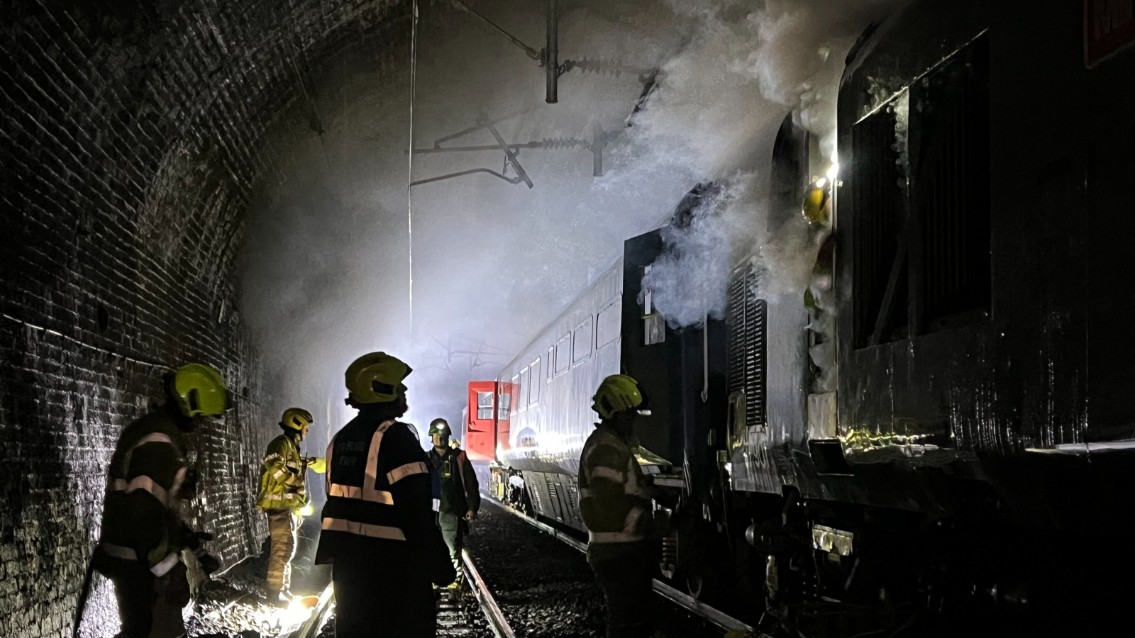Wednesday 20 Mar 2024
Blue light partners join Network Rail to test emergency response plans
- Region & Route:
- North West & Central
Network Rail and partners from across the emergency services have joined forces to test emergency response plans to an ‘incident scenario’ within a railway tunnel just outside of Sutton Coldfield station.
On Saturday (16 March), partners from West Midlands Fire Service, West Midlands Ambulance Service, British Transport Police, West Midlands Police and West Midlands Railway, joined Network Rail to complete some practical emergency rescue training within the railway tunnel at Sutton Coldfield station.
To begin the training exercise, a train, provided by the Rail Operations Group, was ‘dressed’ as if it had struck a fallen tree that had brought down the overhead wires, which provide power to electric trains, and was positioned in the railway tunnel at Sutton Coldfield station. Partners then sprung into action to begin rescuing volunteers posing as train crew and passengers, as if it were a live scenario.
The training exercise, which involved around 250 people, took place through the night from Saturday to Sunday while the railway wasn’t operational and to cause least disruption to passengers and nearby residents. The night-time scenario made rescuing ‘passengers and train crew’ more complex as the response teams had to deal with a demanding environment including; lack of light, confined space underneath the tunnel, no power to the train and ‘smoke’ to imitate a fire.
Martin Colmey, operations director for Network Rail Central said: “Safety is at the heart of everything we do and this invaluable training exercise was a great success. We hope we never have to respond to emergencies such as this, but it has not only enhanced our emergency planning but allowed us and partners to test our joint response and be prepared if needed."
Paul Kitchen, station commander at West Midlands Fire Service, said: "West Midlands Fire Service are proud of our response to a multitude of incident types, including the transport network. We aim to get to serious incidents that pose a risk to life or property in just five minutes, and often work with several partner organisations at a scene.
"That’s why exercises such as this are invaluable – they allow our crews to hone their skills in a realistic but safe environment. They also provide us with the opportunity to test a Multi-Agency response - from the initial call into our Fire Control, through to Command Officer. We were grateful for the opportunity to be involved."
James Williams, head of emergency preparedness at West Midlands Ambulance Service, said: “Overall the exercise was a positive experience for all involved. WMAS committed a significant number of resources which meant we were able to test recent updates to plans and newly implemented triage framework.
"It was great to see all partners working well together in a challenging environment ensuring the focus was to save as many lives as possible using a collaborative approach. These exercises are a great opportunity to work alongside colleagues to test and exercise our arrangements if ever the worst was to happen.”
Chris Hodgekiss, BTP chief inspector, said: "These realistic scenario based training sessions are essential for the personal and professional development of our officers and help us to prepare as a force for major incidents and share joint learning with our industry partners."
Inspector Scott McGarrigle, from West Midlands Police Operations department, said: “This exercise and any lessons learnt as a result put ourselves - and partners - in a stronger position to respond to serious incidents in the future so we can help protect the public."
Jamie Ainsworth, health, safety, security & environment director at West Midlands Railway said: “As the operator on the Cross-City Line, it was imperative to work alongside Network Rail and industry partners to carry out emergency rescue training for staff. Keeping the railway safe is our top priority and it is crucial that railway staff are prepared to deal with emergency incidents effectively.”
Jonathan Gavin-Jones, business development manager for Rail Operations Group said: “Safety is at the heart of everything we do at ROG, which is why, when asked, we wanted to work with Network Rail and partners during this exercise.
For more information on what Network Rail do to keep people safe on and around the railway visit: networkrail.co.uk/communities/safety-in-the-community/
Contact information
Passengers / community members
Network Rail national helpline
03457 11 41 41
Latest travel advice
Please visit National Rail Enquiries
Journalists
Network Rail press office - North West & Central Region
0330 854 0100
NWCmediarelations@networkrail.co.uk
About Network Rail
We own, operate and develop Britain's railway infrastructure; that's 20,000 miles of track, 30,000 bridges, tunnels and viaducts and the thousands of signals, level crossings and stations. We run 20 of the UK's largest stations while all the others, over 2,500, are run by the country's train operating companies.
Usually, there are almost five million journeys made in the UK and over 600 freight trains run on the network. People depend on Britain's railway for their daily commute, to visit friends and loved ones and to get them home safe every day. Our role is to deliver a safe and reliable railway, so we carefully manage and deliver thousands of projects every year that form part of the multi-billion pound Railway Upgrade Plan, to grow and expand the nation's railway network to respond to the tremendous growth and demand the railway has experienced - a doubling of passenger journeys over the past 20 years.
Follow us on Twitter: @networkrail
Visit our online newsroom: www.networkrailmediacentre.co.uk

